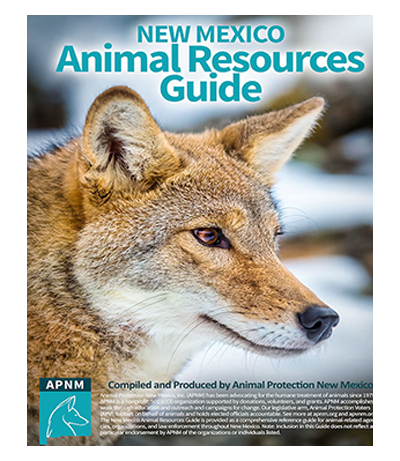August 25, 2004
Bruce Thompson, Director
New Mexico Department of Game and Fish
One Wildlife Way
Santa Fe, New Mexico 87507
Re: Recommended changes to cougar hunt regulations for 2005-2007
Dear Director Thompson:
On behalf of the 3,500 members of Animal Protection New Mexico (“APNM”), we submit these comments to you on New Mexico’s cougar management regulations. Unfortunately, the past Game Commission created reckless regulations that are unfounded in science and have the potential to inflict irreparable harm on New Mexico’s cougar population. However, the current administration has the opportunity to undo these bad policies by implementing regulations based on both common sense and the best science available to the Commission. Below, we identify five major areas in which regulatory change is necessary to allow for a sustainable cougar population.
- Cougar management should be dictated by the best available science, provided by the Hornocker Wildlife Institute study. As you are aware, the most comprehensive study of cougars ever conducted in our nation is Cougars of the San Andres Mountains, New Mexico, by Kenneth A. Logan, et al., of the Hornocker Wildlife Institute (Sept. 1996) (“Hornocker study”). The New Mexico Department of Game and Fish (“Department”) and Game Commission should base its cougar management on the results of this study, as it provides the state with the best scientific data available. APNM’s remaining recommendations for changes to state cougar regulations follow logically from the findings of the Hornocker study, as well as the input and recommendations of Dr. Kenneth Logan, senior researcher of the Hornocker study and coauthor of the book Desert Puma: Evolutionary Ecology and Conservation of an Enduring Carnivore (hereinafter “Desert Puma”) (2001).
- The current cougar quota should be reduced so that on average, no more than approximately 110 cougars are killed each year. This number must include all cougar kills, including those on private land and in bighorn sheep ranges. As the Department acknowledged in a recent public meeting regarding the cougar hunt, no one is certain how many cougars live in the state. Based on estimates of cougar density and habitat in New Mexico being used by the Department, there are believed to be approximately 1,000 adult cougars in New Mexico. The Hornocker study recommends an allowable harvest of 11% of adult cougars for long-range population maintenance. That translates into only about 110 cougars each year. Thus, the current quota of 234 cougars is more than twice as high as the scientifically recommended level. This quota is even more extreme in light of the fact that it does not include the killing allowed year-round on private lands, or within any bighorn sheep ranges. The current cougar quota should be changed such that only 11% of the adult cougar population is killed in total. Significantly, the Department’s own cougar population computer model produces results that correlate exactly with the recommendations of the Hornocker study. The model shows a population crash at eight years with the current harvest limit of 234 cougars (attachment 1). In contrast, the model shows a fully stable population when the quota is reduced to 110 (attachment 2).
- At least two cougar refuges should be established in the state. The Hornocker study recommends the establishment of two refuges – one in northern New Mexico and one in the southern part of the state – of at least 1,000 square miles each. True refuges would serve as “biological savings accounts” to compensate for possible management errors, as well as the uncertainties that exist about the size of the cougar population. Additionally, establishing these refuges is essential to mitigate the effects of the past few years’ extreme quotas. APNM strongly encourages the Department to establish these refuges, with a zero kill quota, to help sustain the cougar population. Current zone quotas do not include any “zero kill” areas, contrary to what was recommended in the Hornocker study.
- The Department must implement cougar population monitoring. Absent the Department’s ability to fund monitoring, the cougar quota should be as conservative as possible. A major recommendation of the Hornocker study is to implement cougar population monitoring. Management decisions and wildlife policy should be based on sound scientific knowledge of current population data and trends. If the Department lacks resources to conduct this monitoring, the cougar quota must be very conservative, to compensate for the lack of knowledge about cougar populations and population dynamics in the state. Current regulations and quotas are far from conservative, and in fact could be easily approaching the point (28% of adult cougars) that the Hornocker study stated would be at the critical boundary between population sustainability and population collapse.
- Regulations allowing year-round hunting on private land, and regulations allowing killing on Game Management Units 29, 30, and 34, should be removed. As established above, the Department’s current cougar quota for sport hunting is dangerously high. In light of this fact, the Department should end year-round hunting of cougar on private land, as well as the killing programs on GMUs 29, 30, and 34. The southern GMU program has cost the state over three quarters of a million dollars, and is an obscene subsidy to the contract trapper and the few ranchers who benefit from his services. In addition, cougar killing on private land must be included toward the overall quota of 11% total adult cougars killed, in order to maintain a sustainable population. In conclusion, if the above recommendations are not implemented, the effects on New Mexico’s cougar population could be disastrous. Dr. Logan, when asked about the impact of even a 28% cougar harvest, stated that “a 28% harvest rate of adults is at the critical boundary between population sustainability and population collapse.” This makes the Department’s current quota proposal — to kill at a 33% rate — alarming and reckless, particularly when the Department has failed to provide APNM with any scientific evidence supporting the current harvest limit.
Thank you for your time, and thank you for considering our comments. We look forward to discussing these issues with you.
Very sincerely,
Elisabeth Jennings, Executive Director
Katrina Albright Hummell, Esq., Wildlife Campaigns Manager
cc: R. J. Kirkpatrick, Luke Shelby








